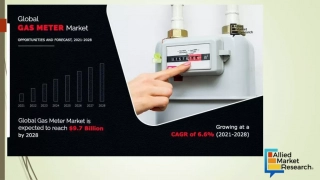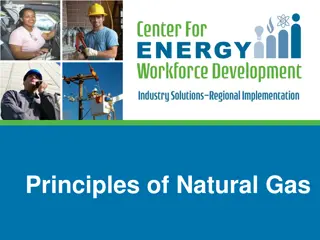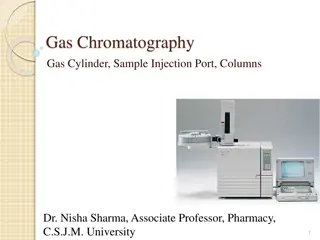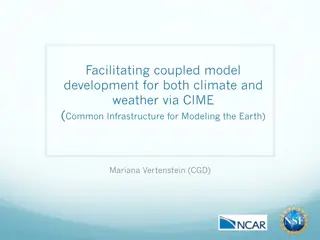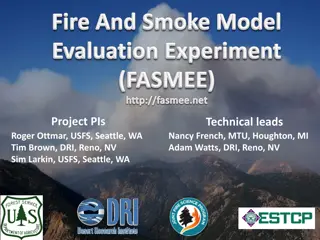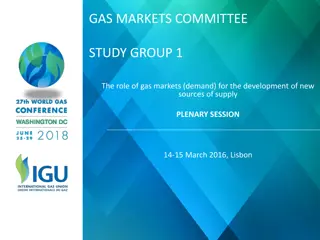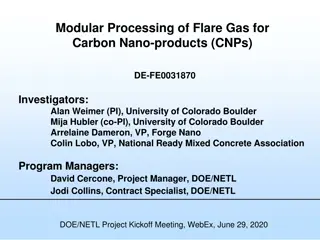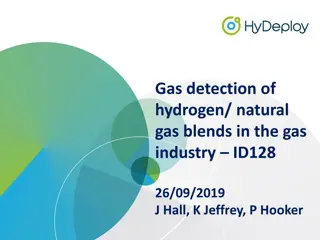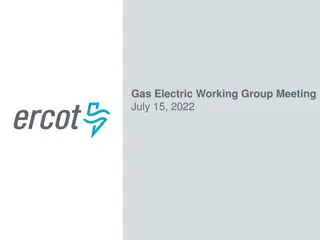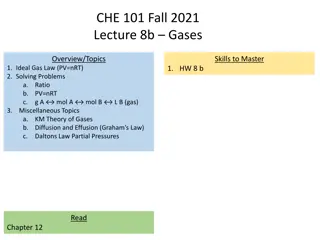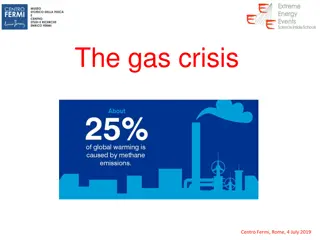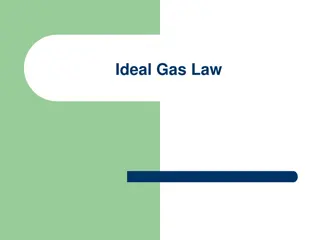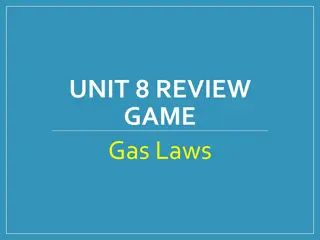Challenges in Modeling Coupled Gas and Power Networks
This literature review presentation delves into the complexities of interdependent gas and power networks, focusing on the modeling of power flow, gas flow, and coupling elements. Explore the practical aspects of linear models used in predicting infrastructure needs and understanding the dynamics of storing surplus renewable electricity through power-to-gas technology.
Download Presentation

Please find below an Image/Link to download the presentation.
The content on the website is provided AS IS for your information and personal use only. It may not be sold, licensed, or shared on other websites without obtaining consent from the author.If you encounter any issues during the download, it is possible that the publisher has removed the file from their server.
You are allowed to download the files provided on this website for personal or commercial use, subject to the condition that they are used lawfully. All files are the property of their respective owners.
The content on the website is provided AS IS for your information and personal use only. It may not be sold, licensed, or shared on other websites without obtaining consent from the author.
E N D
Presentation Transcript
Literature review Presentation 16/06/2021 1
Introduction Renewable energies provide a large part of European electricity, but they pose challenges for network management. Power-to-gas allows for storing surplus renewable electricity on the short or long term. Gas and power networks are thus increasingly interdependent. In order to predict infrastructure needs, the gas and power networks need to be modelled together. 2
Purpose Examine the models used for coupled gas and power networks Take a closer look at the linear models Discuss practical aspects 3
Literature review Power flow models Gas flow models Coupling elements Numerics Test networks 4
Power network models Conservation law: Kirchhoff s current law For each node j, ?? ? ????= 0 Two standard models: AC and DC power flow DC is the linearization of AC Both are used throughout the literature on coupled networks. Power injection at nodes in DC model: ? = ?? Physical constraints: Generator capacity Line capacity Supply-demand balance, provided by slack generator 5
Gas network models: flow in lines Flow in lines: standard flow equations (quadratic) used in most papers Gas flow in line ij: ???= ??? ?? 2 ?? 2 No standard linear representation of flow First-order Taylor expansion of the above (Fang et al. 2019) Linear pressure analog Lijbased on pressure ratio pi/pj (Ayala & Leong 2013) Linear gas flow: ???= ???(?? ??) Transport load model (Infrastructure Outlook): ? = ?? Constraints on line capacity and nodal pressures 6
Gas network models: nodes and storage At nodes: mass conservation Long-term, large-scale storage Treated as a source or a sink depending on the needs Constraints of min/max capacity, and injection/withdrawal rates Short-term storage: linepack Consists of varying the pressure in pipelines to create a small reserve of gas Used for immediate adjustments of supply in response to demand fluctuations The possibility for storage is the major difference between the gas and power networks, along with the reaction time Storage is not systematically modelled 7
Generation shift factor and gas shift factor The generation shift factor (GeSF) is part of the DC power flow model. It gives the change in flow in branches (Pij) for a given change in supply at nodes (Pm), such that ???= GeSF??,? ?? ? The gas shift factor (Li et al. 2017) is an analogous concept, with ???= GSF??,??? ? It is unclear how the GSF should be calculated Potential research goal: formulate a linear gas network model so that the GSF can be used and both networks are modelled in a similar way 8
Coupling the networks Interaction between energy carriers happens at coupling nodes: Gas-fired power plants: gas is burned to obtain electricity via turbines. Power-to-gas facilities: surplus power is converted to hydrogen or synthetic natural gas (SNG). Electric compressors: gas is compressed to compensate for pressure loss in pipelines. This demands energy, which may be provided by a gas turbine or by electricity. Energy demand may be modelled with a linear equation (Geidl & Andersson 2007). The round-trip conversion efficiency of hydrogen is higher than that of SNG, but hydrogen needs its own infrastructure. 9
Numerics and optimization In general, coupled models are large, underdetermined systems of nonlinear equations. Common strategy: give enough initial data that the system is fully determined and use Newton- Raphson. NR s convergence is sensitive to initial conditions and adequate initial data is difficult to obtain. Otherwise: try to find an optimal solution Nonlinear optimization is tricky: either linearize (piecewise) or use fancy algorithms Also sometimes used: construct a linear problem Linear and nonlinear models may be combined, often one for each energy carrier 10
Test networks and software Standard IEEE test networks for electricity models No such standard exists for gas, but a library has been assembled for testing purposes (GasLib) Very small networks to be used for initial testing; can be studied analytically (to an extent) For implementation of power network analysis: MATPOWER library Some MATLAB libraries may be usable for gas network analysis 11
Summary Modelling of power networks is a well-studied problem; many tools available to help with implementation Gas networks are trickier: No standard linear model, but many ways to simplify One library of test networks; not standard yet Two schools for coupled models: Solve for gas flow and power flow separately, with data exchange between the two Solve all together Some constraints (conservation of mass and power, capacity) need to be observed but the physics can be simplified 12
References X. Fang, M.T. Craig, and B.-M. Hodge. 2019. Linear Approximation Line Pack Model for Integrated Electricity and Natural Gas Systems OPF . In 2019 IEEE Power & Energy Society General Meeting (PESGM), 1 5. Atlanta, GA, USA: IEEE. L.F. Ayala H. and C.Y. Leong. 2013. A Robust Linear-Pressure Analog for the Analysis of Natural Gas Transportation Networks . Journal of Natural Gas Science and Engineering 14 (September): 174 84. G. Li, R. Zhang, T. Jiang, H. Chen, L. Bai, and X. Li. 2017. Security- Constrained Bi-Level Economic Dispatch Model for Integrated Natural Gas and Electricity Systems Considering Wind Power and Power-to- Gas Process . Applied Energy 194 (May): 696 704. M. Geidl and G. Andersson. 2007. Optimal Power Flow of Multiple Energy Carriers . IEEE Transactions on Power Systems 22 (1): 145 55. M. Schmidt, D. A mann, R. Burlacu, J. Humpola, I. Joormann, N. Kanelakis, T. Koch, et al. 2017. GasLib A Library of Gas Network Instances . Data 2 (December): 40. 13
Research questions: model construction How to formulate a unified linear model for the combined network? How unified does it need to be? How to reflect the different reaction times of gas and power? (Is that necessary, since we compute steady state flow?) Transport load model for gas: use it? Compatible with GSF? How to implement communication between gas and power networks? How does my model compare with the one used in the Infrastructure Outlook? 14
Research questions: input and output How much input data is needed? What constitutes good input data? What are the consequences of bad input data? How accurate are the simulation results? How much accuracy is needed? How can the accuracy be evaluated? Which infrastructure and energy generation scenarios are feasible? Desirable? How much interaction between gas and power networks? Where and when? What are the consequences of network coupling on infrastructure needs? 15
Upcoming work Further study linear gas models: Decide which formulation is the most appropriate for my work Try it on toy networks: analytical study and implementation Check that I have a functional implementation of power network model Work out the details of coupling Calculate relevant coefficients and constraints Formulate a combined gas&power model Ideally, define gas shift factor so that the gas model looks like the power model 16


